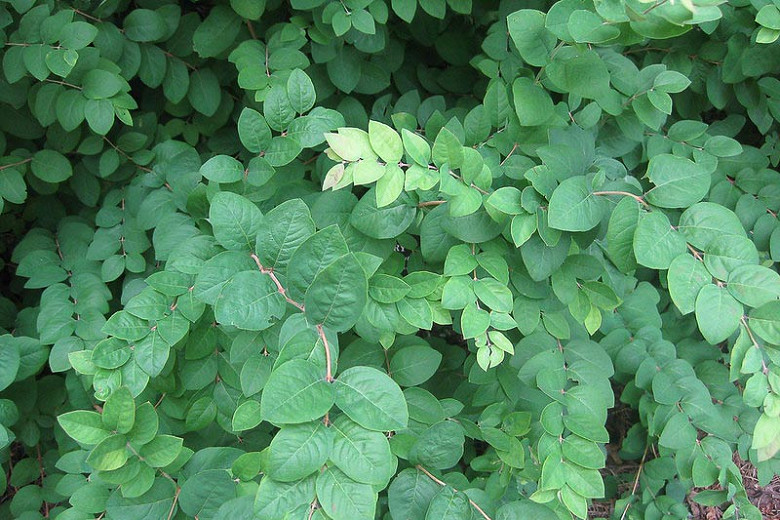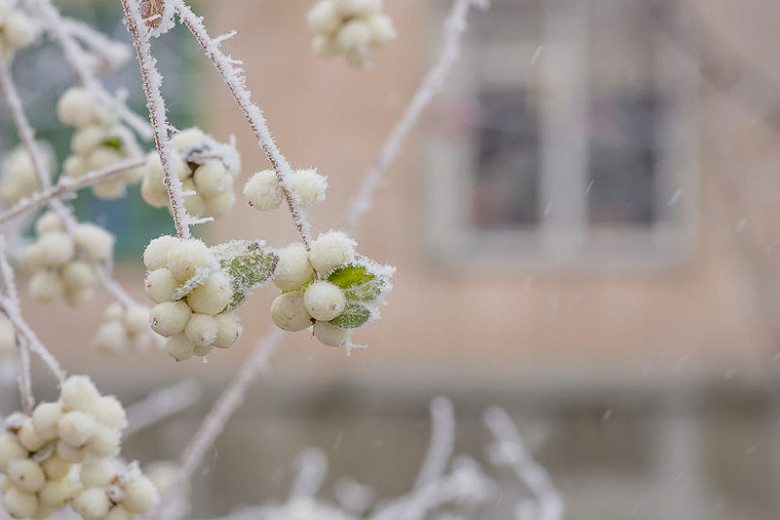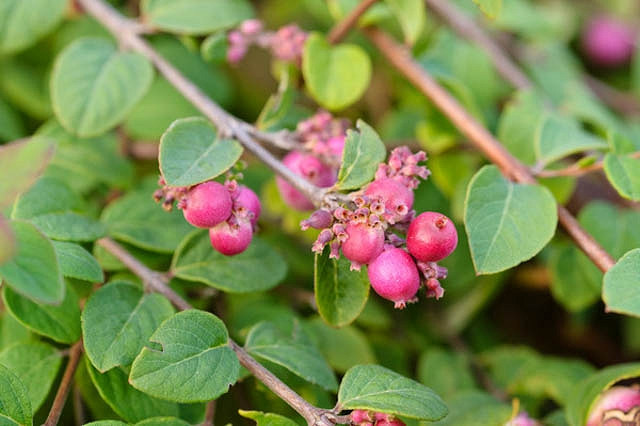Symphoricarpos orbiculatus (Coralberry)
Noted for its showy berries, Symphoricarpos orbiculatus (Coralberry) is a bushy deciduous shrub with gracefully arching stems clothed with dark green, ovate leaves, 2.5 in. long (6 cm). The dense foliage remains attractive from spring to frost. From spring to midsummer (depending on the geographic location), a profusion of small, inconspicuous, bell-shaped, white, or pinkish flowers are borne along the stems. They are followed by abundant and attractive clusters of round, coral-pink to purple berries which mature in the fall. They persist through most of the winter, adding terrific color and interest to the winter landscape. Songbirds, ground birds, and small mammals enjoy them in the winter months. Coralberry spreads by ground-hugging stolons to form extensive colonies and spreads by rooting at the nodes where its arching canes touch the ground. Thriving on neglect, Symphoricarpos orbiculatus is an excellent choice for a woodland garden, bank stabilization, or as a tall ground cover.
- Grows up to 2-5 ft. tall (60-150 cm) and 4-8 ft. wide (120-240 cm).
- A full sun to part shade lover, this plant is easily grown in moist, fertile soils. Tolerates full shade and a wide range of soils including clay soils and dry soils. Drought and pollution tolerant.
- Generally pest and disease free, but watch for occasional anthracnose and powdery mildew. Deer resistant.
- Excellent as an informal hedge or massed in mixed shrub borders, woodland gardens, slopes (and erosion control).
- To keep it compact, cut it back to knee-high every 5 to 10 years. If it gets too leggy, cut back to the ground, and it will come back bushier and with more berries the next year.
- Propagate by softwood cuttings in summer or hardwood cuttings in autumn. Rooted suckers can be transplanted in autumn.
- Fruit can cause mild stomach upset if ingested.
- Native to the eastern United States, Mexico.
Requirements
| Hardiness | 2 – 7 |
|---|---|
| Heat Zones | 1 – 7 |
| Climate Zones | 1, 1A, 1B, 2, 2A, 2B, 3, 3A, 3B, 4, 5, 6, 7, 8, 9, 10, 11, 14, 15, 16, 17, 18, 19, 20, 21 |
| Plant Type | Shrubs |
| Plant Family | Symphoricarpos – Snowberries |
| Exposure | Full Sun, Partial Sun, Shade |
| Season of Interest | Spring (Mid,Late)Summer (Early,Mid,Late)FallWinter |
| Height | 2' – 5' (60cm – 150cm) |
| Spread | 4' – 8' (120cm – 240cm) |
| Spacing | 72″ – 96″ (180cm – 240cm) |
| Water Needs | Average |
| Maintenance | Low |
| Soil Type | Chalk, Clay, Loam, Sand |
| Soil pH | Acid, Alkaline, Neutral |
| Soil Drainage | Moist but Well-Drained, Poorly Drained, Well-Drained |
| Characteristics | Dried Arrangements, Cut Flowers, Showy, Fruit & Berries |
| Native Plants | United States, Midwest, Illinois, Indiana, Iowa, Kansas, Michigan, Minnesota, Missouri, Nebraska, Ohio, South Dakota, Wisconsin, Northeast, Connecticut, Delaware, Massachusetts, Maryland, New Jersey, New York, Pennsylvania, Rhode Island, Vermont, Utah, Southeast, Alabama, Arkansas, Florida, Georgia, Kentucky, Louisiana, Mississippi, North Carolina, South Carolina, Tennessee, Virginia, West Virginia, Southwest, Oklahoma, Texas |
| Tolerance | Clay Soil, Deer, Drought, Dry Soil |
| Attracts | Birds |
| Garden Uses | Banks and Slopes, Ground Covers, Hedges and Screens |
| Garden Styles | Informal and Cottage, Traditional Garden |




